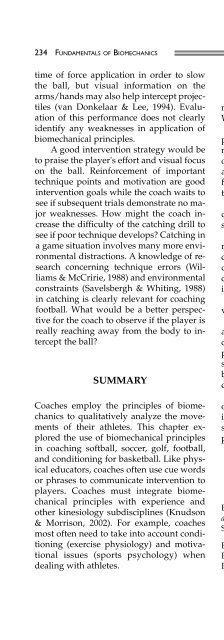Fundamentals of Biomechanics
Fundamentals of Biomechanics
Fundamentals of Biomechanics
You also want an ePaper? Increase the reach of your titles
YUMPU automatically turns print PDFs into web optimized ePapers that Google loves.
234 FUNDAMENTALS OF BIOMECHANICS<br />
time <strong>of</strong> force application in order to slow<br />
the ball, but visual information on the<br />
arms/hands may also help intercept projectiles<br />
(van Donkelaar & Lee, 1994). Evaluation<br />
<strong>of</strong> this performance does not clearly<br />
identify any weaknesses in application <strong>of</strong><br />
biomechanical principles.<br />
A good intervention strategy would be<br />
to praise the player's effort and visual focus<br />
on the ball. Reinforcement <strong>of</strong> important<br />
technique points and motivation are good<br />
intervention goals while the coach waits to<br />
see if subsequent trials demonstrate no major<br />
weaknesses. How might the coach increase<br />
the difficulty <strong>of</strong> the catching drill to<br />
see if poor technique develops? Catching in<br />
a game situation involves many more environmental<br />
distractions. A knowledge <strong>of</strong> research<br />
concerning technique errors (Williams<br />
& McCririe, 1988) and environmental<br />
constraints (Savelsbergh & Whiting, 1988)<br />
in catching is clearly relevant for coaching<br />
football. What would be a better perspective<br />
for the coach to observe if the player is<br />
really reaching away from the body to intercept<br />
the ball?<br />
SUMMARY<br />
Coaches employ the principles <strong>of</strong> biomechanics<br />
to qualitatively analyze the movements<br />
<strong>of</strong> their athletes. This chapter explored<br />
the use <strong>of</strong> biomechanical principles<br />
in coaching s<strong>of</strong>tball, soccer, golf, football,<br />
and conditioning for basketball. Like physical<br />
educators, coaches <strong>of</strong>ten use cue words<br />
or phrases to communicate intervention to<br />
players. Coaches must integrate biomechanical<br />
principles with experience and<br />
other kinesiology subdisciplines (Knudson<br />
& Morrison, 2002). For example, coaches<br />
most <strong>of</strong>ten need to take into account conditioning<br />
(exercise physiology) and motivational<br />
issues (sports psychology) when<br />
dealing with athletes.<br />
DISCUSSION QUESTIONS<br />
1. Are certain biomechanical principles<br />
more important to the advanced athlete?<br />
Which and why?<br />
2. Athletics coaches <strong>of</strong>ten have the opportunity<br />
<strong>of</strong> working closely with a smaller<br />
number <strong>of</strong> performers over a greater length<br />
<strong>of</strong> time than other kinesiology pr<strong>of</strong>essionals.<br />
Does this concern for long-term performance<br />
increase or decrease the importance<br />
<strong>of</strong> biomechanical principles?<br />
3. Have coaching organizations adequately<br />
promoted continuing education in<br />
sport sciences like biomechanics?<br />
4. Which biomechanical principles are<br />
relevant to athlete quickness? Can biomechanics<br />
be used to coach an athlete to be<br />
quicker? If so, how does this improvement<br />
compare to improvement from conditioning?<br />
5. Are biomechanical principles relevant<br />
to talent identification?<br />
6. While the “daddy” videos discussed<br />
above might give the coach a general indication<br />
<strong>of</strong> the swings <strong>of</strong> players, what important<br />
aspects <strong>of</strong> golf competition may not<br />
show up on these videos? What important<br />
biomechanical issues might be difficult to<br />
determine from inadequate camera views?<br />
7. Prioritize the following factors based<br />
on their importance in coaching beginning,<br />
intermediate, and advanced athletes for a<br />
specific sport: biomechanics, maturation,<br />
physiology, psychology.<br />
SUGGESTED READING<br />
Brancazio, P. (1984). Sport science: Physical laws<br />
and optimum performance. New York: Simon &<br />
Schuster.<br />
Brody, H. (1987). Tennis science for tennis players.<br />
Philadelphia: University <strong>of</strong> Pennsylvania<br />
Press.






